PSY 324 Exam 2
1/63
There's no tags or description
Looks like no tags are added yet.
Name | Mastery | Learn | Test | Matching | Spaced |
|---|
No study sessions yet.
64 Terms
Rules
concept may be represented as strict definition, usually expressed
linguistically
Rules Weakness
difficult to generate a comprehensive rule to adequately define a part. category
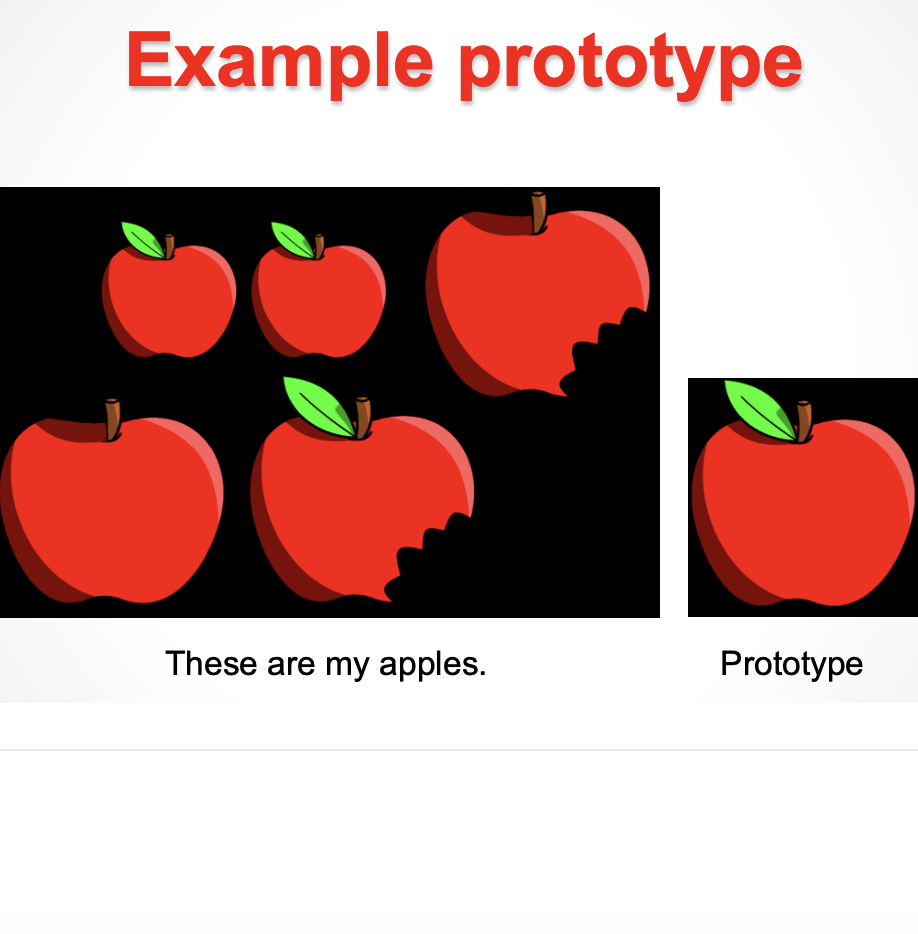
Prototypes
concept may be represented as aggregate entity which on avg most frequently reflects essential features of category
Prototype Weaknesses
prototype may not necessarily reflect a true instance of a category, sometimes struggle to predict empirical results
Exemplars
concept is 1+ memory traces of category members, objects and events categorized based on similarities to sets of exemplars in memory

Category Structure
refers to 3 details: # of items in category, dimensions that determ category membership, and relationships betw those dimensions and their values
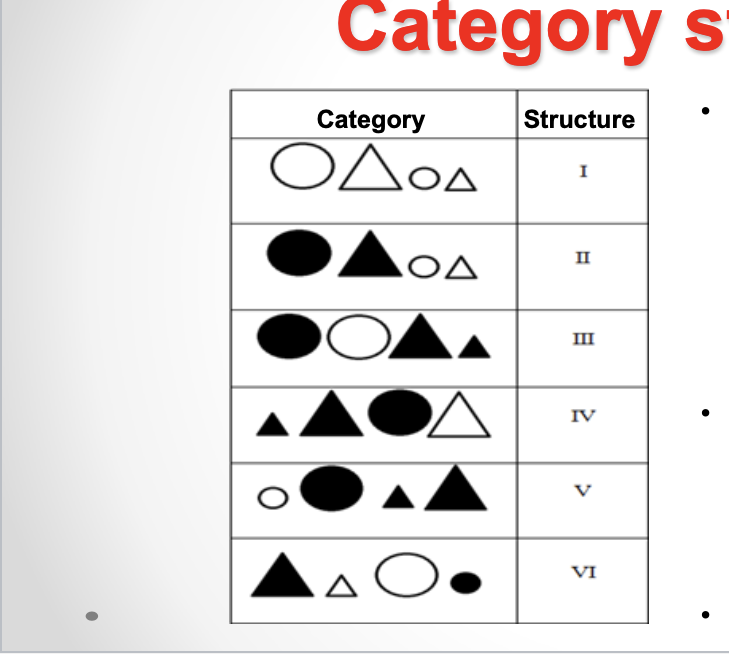
Category Structure 2
according to part. accuracy rates in serial presentation categorization task, consistent order emerged for difficulty of six structures; I < II < [III, IV, V] < VI
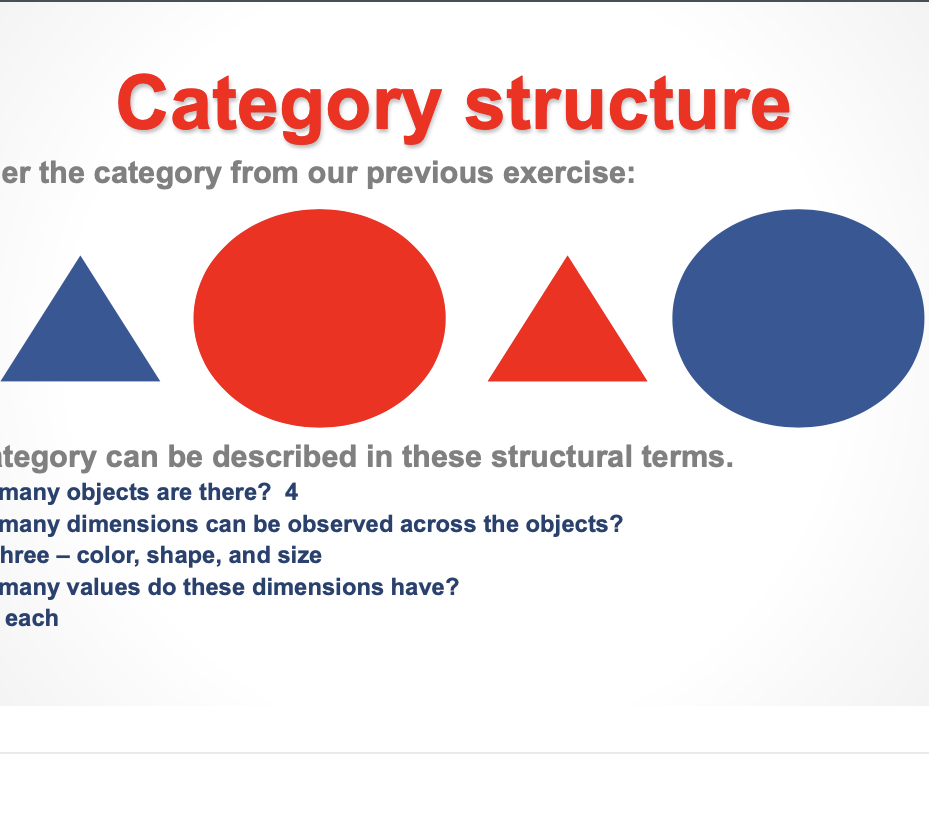
Category Structure Example
how many objects are there? 4; how many dimensions can be observed across the objects? 3 – color, shape, and size; how many values do these dimensions have? 2 each
Six Structures Studied by Shepard, Hovland, & Jenkins (1961)
4 objects defined over 3 binary dimens can be arranged into 6 structures, all diff inter-dimen relationships, 32[4] - VDO
Hierarchical Concepts
superordinate (animal), basic level (dog), and subordinate (poodle)
Basic Level Advantage
“cat” is more likely R than either “animal” (superordinate) or “Burmese cat” (subordinate)
Conceptual Combination
concepts combine to make sense of novel entities, e.g. pink chalkboard, we form mental images w/o any encounter
Iconic Memory
visual stimuli
Echoic Memory
auditory stimuli
Haptic Memory
tactile stimuli

Cattel (1886)
found parts could recall 4-5 letters from array, consistent regardless of how many letters in array (min. 6)
Sperling (1960)’s Partial Report Technique
parts. heard tone as array was presented indicating which row to report
Sperling (1960)
refined Cattel’s experiment to examine span of apprehension; partial report technique revealed around 75% of letters reported, even when array featured more letters
Sperling (1960) Implications
iconic memory can’t survive long and must be passed on to short-term memory to be used
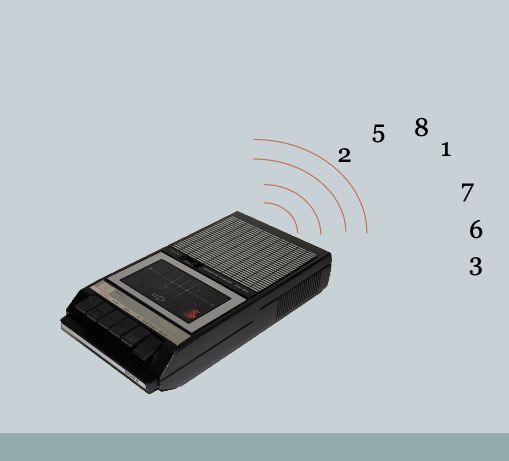
Crowder & Morton (1969)
examined auditory echoic memory with a digit recall experiment, parts’ ability to recall last 9 digits (out of 45) limited
Peterson and Peterson (1959)
est. temporal limitation of short-term memory to be 18s (current est 20-30s); state 4-letter consonant group, 3-digit #, count backwards by 3s for 30s
Conrad (1964)
subjects presented w/string of six letters, distraction task – reading digits aloud, errors often rhymed (e.g., “D” instead of “B”), acoustic encoding!
Wickens (1972)
evidence for semantic encoding, subjects presented w/3 members of some category (e.g. flowers – rose, tulip, daisy)
Wickens (1972) Distraction Task
counting backward by threes, repeated 4x w/in category, perf. worsened, when a new category introduced, perf. improved
Miller (1956)
ppl evidence memory limitations to approx 7 chunks; chunk is grouping of info to make memory more effective, e.g. phone #
Baddeley and Hitch (1974)
working memory theory: working memory provides temporary storage and manipulates info for cognitive use
Short-Term Memory
intermediary system betw info in env and perm memory storage, allows info to be processed into/extracted from perm storage
Acoustic Encoding
converting auditory info, such as sounds and words, into form that can be stored and retrieved by brain
Semantic Encoding
converting info into memory based on meaning or significance
Working Memory and Its Components
provides temporary storage and manipulates info for cognitive use
Serial Position Effect
probability of recalling an item in a list depends upon where it
fell in list sequentially
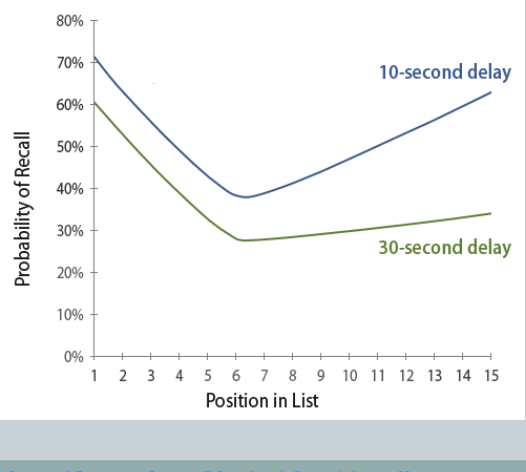
Primacy Effect
first item(s) in a list tend to be easier to recall
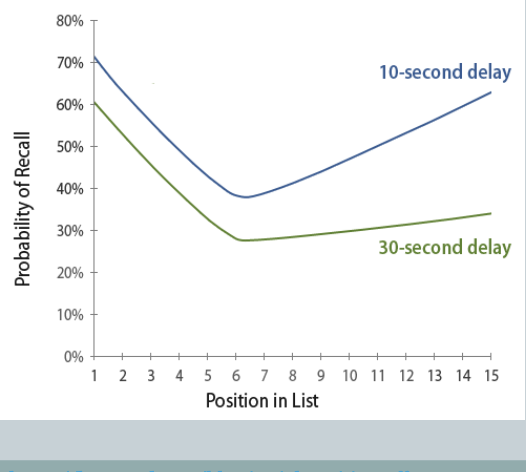
Recency Effect
last item(s) in a list tend to be easier to recall
Levels of Processing Effect (Craik & Tulving, 1975)
Case (upper or lower)
Rhyme
Does it fit in a sentence?
parts answered questions like these for 60 words total, later given list of 180 words and asked to recall which ones they previously saw
Craik & Tulving (1975) Findings
17% of words for case (visual encoding), 37% of words for rhyme (auditory encoding), 65% of words for meaning (semantic encoding)
Context Effects
list of items learned underwater better remembered underwater (and same for land)
Spacing Effects
repetitions spaced close - worse recall; repetitions spaced farther apart - better recall
Forgetting - Decay
duration of memory finite w/o use; eventually lost, robust evidence that memory recall worsens w/o being revisited
Forgetting - Interference
some memories can inh recall of others; Retroactive interference – new info interferes with old, Proactive interference – old info interferes w/new
Forgetting - Overwriting
earlier memories interfered with, to pt of erasure, in favor of new memories
Explicit/Declarative Memory
memories of factual info; semantic, episodic, conscious recall
Episodic Memory
memory of autobiographical events, e.g. birthday parties, specific conversations, yesterday’s lecture
Semantic Memory
general knowledge, facts, and categories; org by content (pen recalls pencil), allows inference, not tied to origin of memory (we don’t remember first pencil)
Hierarchical Model of Semantic Memory
specific memories are nodes, and assoc by links; reaction times are slower in recall the farther one must climb ladder, e.g. is a robin a bird? Faster, Is a robin an animal? Slower
Anterograde Amnesia
loss of ability to remember new info
Retrograde Amnesia
loss of ability to remember old info, Korsakoff Syndrome - RA for both episodic and semantic info, AA impairs both!
Implicit Memory
any memories not consciously retrieved
Procedural Memory
retrieved memory relating execution of actions, memories accessed difficult to verbalize, e.g. driving
Jacoby & Dallas (1981) Results
levels of processing (semantic, acoustic, and visual) made big
difference in explicit condition, and nearly no diff in implicit condition!
Relationship of Understanding and Memory
processing info for understanding breeds memory

Schemas
structured “units” of knowledge that package pieces of info contained in memory and relations betw them; each item called a slot
Reconstructive Memory
reconstructing complex memories (sometimes incorrectly)
Eyewitness Testimony
memory impacted for worse by misleading info or misleading questions, Loftus, Burns, & Miller (1978) - misleading q with 38% correct answer rate v. 85% in a fair q (misinfo effect)
Misinformation Effect
causes- overwriting (replaces existing info), source confusion (true memory confused w/simulated one), and misinfo acceptance (simply trust that info given is true)
Flashbulb Memories (Role of Personal Impact)
memories of highly sig events, or those “burned” into our minds; personal impact critical in creating true flashbulb memory - Neisser & Harsch (1992)
Repression
lose ability to recall traumatic memory of event until later in life
Suppression
neuroscience research suggests humans w/some control over suppressing intrusive memories
Analog Representations
mimic structure of a referent object incl relationships among its components
Propositional Representations
abstract relations that do not reflect any sensory modality, such as direction from A to B
Mental Rotation
our ability to perform these rotations suggests some kind of internal representation
Selective Interference
imagined stimuli interfered with their perception of signals, evidence mixed
Picture Superiority Effect
converging evidence suggests that we remember images and pictures more effectively than abstract info
Dual-Coding Hypothesis
images can be stored as analogs or propositions, but other knowledge and info may not have analog option
Face Recognition
humans uniquely good at recog facial details, more than for most other types of images